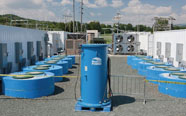Amazing Flywheels
FAST AND RESPONSIVE
Published In: EnergyBiz Magazine September/October 2011

THIS SUMMER, an innovative 20-megawatt capacity flywheel energy storage plant was officially opened in Stephentown, N.Y.
The plant, the largest of its type in service in North America today, will be used by the New York Independent System Operator to help store excess energy when power generated exceeds the load. When load levels increase, the energy can be delivered back to the grid.
Beyond acting as a buffer for variable load levels, the flywheels will also help with frequency regulation. In that regard, all of the independent system operators that operate regional grids in the United States keep the electric frequency at 60 hertz. When the supply of electricity exactly matches the demand, grid frequency is held at a stable level. However, when there is a mismatch in supply and load, operators have had to slightly modify power output up and down to balance loads and smooth out frequency differences.
Load balancing and frequency regulation are important today, but system operators expect greater challenges in the near future as more electricity is generated from renewable sources. The reason: The variability of wind, hydro, and solar power can lead to imbalances between supply and load levels.
"We've set a goal of meeting 45 percent of New York's electricity needs by the year 2015 through a combination of investments in energy efficiency and renewable energy," said Francis J. Murray Jr., president and CEO, New York State Energy Research and Development Authority. "We know that's an ambitious target, but [the] flywheel plant is exactly the kind of technology investment we need if we're going to accomplish this important objective."
That sentiment was echoed by the system operator. "Energy storage systems are critical to our future and it's great to see pioneering technology bring new solutions to our need," said Stephen G. Whitley, president and CEO of the New York Independent System Operator.
That sentiment was echoed by the system operator. "Energy storage systems are critical to our future and it's great to see pioneering technology bring new solutions to our need," said Stephen G. Whitley, president and CEO of the New York Independent System Operator.
A single flywheel spinning at top speed can deliver 25 kilowatt-hours of energy at a 100-kilowatt power level for 15 minutes. The plant gets its 20-megawatt storage capacity by connecting 200 flywheels in parallel.
The flywheels offer some advantages over other previously used frequency regulation technology and methods.
For one, the flywheels are more responsive. Power can be throttled up or down in less than four seconds after receiving commands to do so.
A second benefit is that the plant should have a longer operating lifetime with lower operating costs. When frequency regulation is done using traditional generators, the changes in power output causes greater wear and tear on equipment. This can increase maintenance costs and shorten equipment lifecycles. Beacon Power claims its flywheels are "built for 20 years of virtually maintenance-free operation."
Additionally, unlike conventional fossil fuel-burning frequency regulation plants, the flywheels do not consume fuel, produce particulates or generate emissions. According to Beacon Power, "this helps make it possible to rapidly permit and site a 20-megawatt flywheel-based plant almost anywhere on the grid relatively close to a transmission line."
Copyright © 1996-2011 by CyberTech, Inc. All rights reserved.
To subscribe or visit go to: http://www.energybiz.com